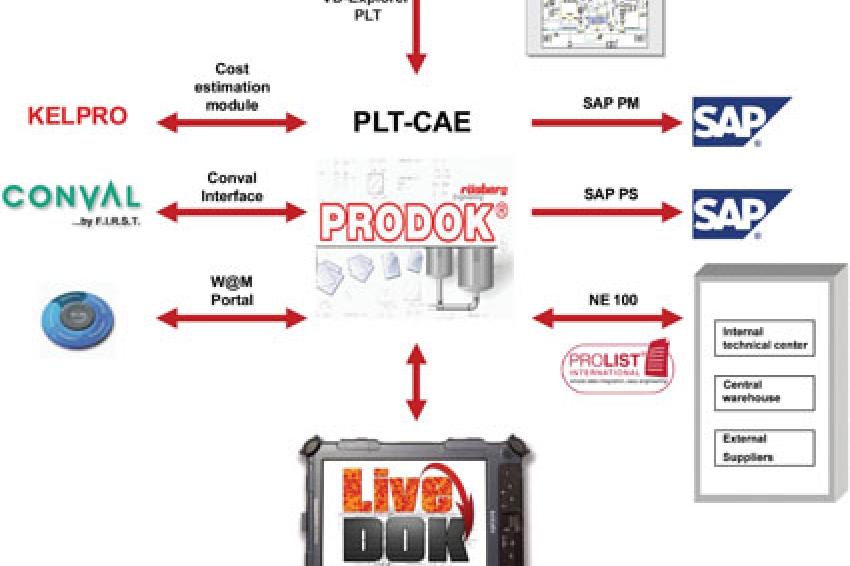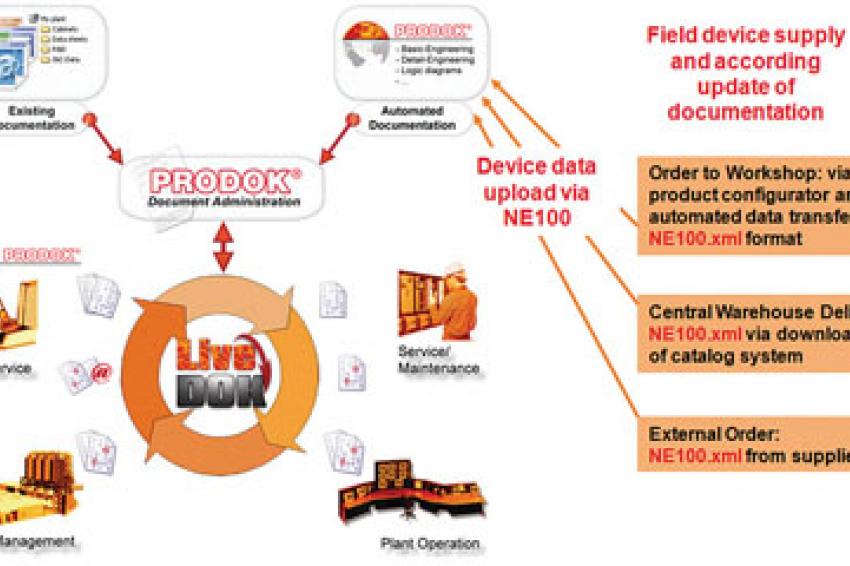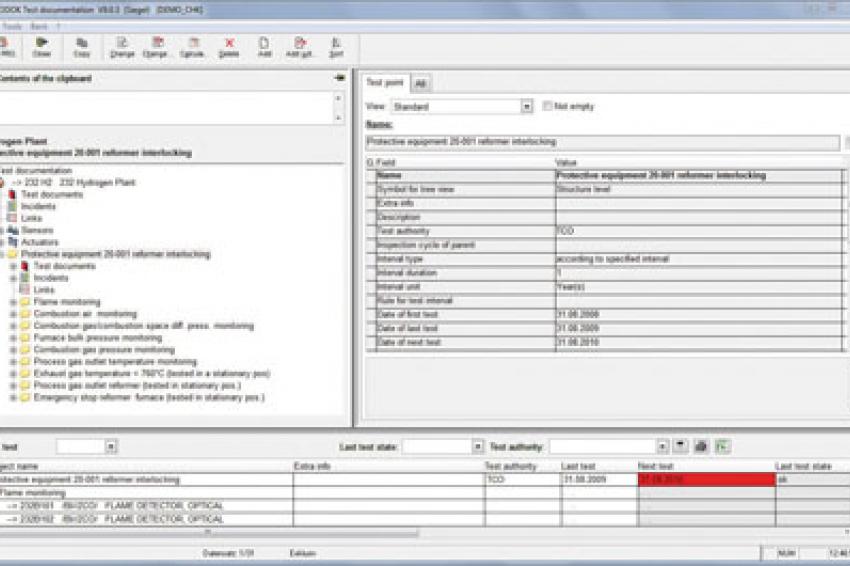The Benefits Of An Instrumentation And Control Planning System
What Are The Benefits Of An Instrumentation And Control Planning System?
Necessary Support - In order to operate a plant safely and reliably, the first prerequisite is to know exactly what shape it is in. It is essential for the plant documentation to reflect plant reality as accurately as possible. Here, instrumentation and control planning systems (I&C-CAE systems) provide the necessary support. In the classic process industry the plants involved are usually large production plants consisting of individual plant components which are mostly non-centrally organized. These individual components are often built up gradually. Depending on their date of construction, an I&C-CAE system may often not have been planned in originally. It would then have to be integrated into an already-existing IT environment.
Just over 10 years ago now, BASF also required an I&C-CAE system capable of working reliably with the software systems already installed there. This requirement was in itself a strong argument for using the I&C planning system Prodok (see Text Box 1) by Roesberg Engineering. In the meantime, 10 years on, not only BASF's Ludwigshafen site, but also the sites in Antwerp, Schwarzheide and Tarragona, as well as smaller BASF sites in Central and South America, are working with the tool developed by the automation experts from Karlsruhe.
Simplicity Of Integration
It isn't possible for everyone to do all tasks equally well. Thus, the automation experts concentrate on their core competence of instrumentation and control engineering, while ensuring that their I&C system provides interfaces to the software of other manufacturers. Where software is concerned, rather than: "Everything from one hand," the overriding philosophy is: "The Best of Everything!" - which also means independence from specific manufacturers. Interfaces are developed according to the user's requirements in each case.
Fig. 1 shows the interfaces in use at present at BASF: P&IDs are transmitted to Prodok via the PD-Explorer. There is an interface to SAP for transmission of data from the technical sites, i.e. the points where maintenance measures have to be carried out (SAP PM). These are automatically identified and updated if there are changes. Via another interface, specifications for individual instrumentation and control devices are transmitted for ordering purposes (via SAP PS to SAP MM). To keep an eye on costs at all times, there is an export from the I&C-CAE-System to BASF's own cost estimation module Kelpro. Calculation data for valves and differential pressure transmitters pass to the calculation program Conval, from which the results are re-transmitted. Of course, there is also an interface to LiveDok (see Text Box 2) for the maintenance of digital plant documentation.
Standardization: Much in Demand
In addition to these, an NE-100 interface is used. Namur Recommendation 100 defines formulations that improve communication when purchasing I&C equipment and enables electronic data exchange (Fig. 2) . BASF uses this standard for inquiries and orders to external suppliers. But NE-100 is also used for internal ordering: When a device is requested from the central warehouse, a download of an NE100.xml document containing information about the device is activated at the same time. This information is integrated into Prodok and is then available for plant documentation. A similar system is used for configuration orders to the internal Automation Engineering Technical Center. Here the configuration order is issued in the form of precise specifications in an NE-100 document set.
The Center configures the devices that have been ordered in accordance with the specifications, adds further information to the NE-100 document if appropriate and then delivers the device together with the relevant NE-100 XML file, which can then be integrated into the plant documentation. Special forms are not only used to transmit the necessary information for ordering and bidding purposes; they can also be used to supply a wide range of information about a device, which can then form an input into plant documentation. Thanks to appropriate interfaces, data import is possible at the touch of a button and time-consuming, potentially inaccurate manual data entry is a thing of the past.
Regarding the depth of information made available for plant documentation, Endress+Hauser's W@M-Portal one step further. Here, at the touch of a button, details of devices from this manufacturer can be retrieved via an internet link, including stored master data, documentations, inspection certificates, ATEX certificates, product-specific spare parts lists and events occurring over the whole life cycle. For this purpose, too, an interface has been defined in Prodok.
A ‘Living'Plant Needs ‘Living' Documentation
Changes are continually being made to plants in the process industry, whether due to maintenance, to keep them state-of-the-art, or because changes in legislation, for instance health and safety regulations, require it. Changes also need to be consistently documented. In this respect, electronic plant documentation has unbeatable advantages, as Martin Dubovy (fig. 3), head of the IT and I&C Departments at Roesberg Engineering, explains: "BASF now uses LiveDok for its digital I&C plant documentation. With LiveDok, a maintenance specialist carries the current documentation with him on his PDA or tablet PC any time he attends to the plant. He can also - using a simple tool - enter any changes made to the plant on his portable device (fig. 2). Changes undertaken in this way are centrally stored and are immediately available to all plant employees. So for instance, the Service Center in charge of Emergency Maintenance can now access the digital I&C documentation, and can thus react faster when problems occur."
However, not only does constantly updated documentation provide the basis for reliable, efficient plant operation - it is also a requirement necessitated by legal provisions and by increasingly stringent occupational safety regulations.
Standardization: Simplifies Work
BASF's Ludwigshafen site comprises numerous individual plants, each with 500 to 18,000 measuring points. There is an increasing need for cross-plant work. In these circumstances, service and maintenance are greatly simplified if all plant documentation is available in standard form. Thus for instance over the past few years clear input formulations have been defined for P&IDs at BASF. This also improves safety, because fewer misunderstandings occur when reading plans with a standardized structure.
The I&C-CAE system also accommodates this idea of standardization. Ralph Roesberg, managing partner of Roesberg Engineering, explains: "Instead of many different documents in various formats such as Excel, PDF or CAD, with us all I&C information is integrated into one system in standardized form." To ensure that the same devices always have the same designation, details of the most important devices used in the plants have been entered in a central master database. If a device is to be represented in the I&C-CAE system, the user selects it from this standard library (fig. 6). Although the initial recording of the information is relatively time-consuming, the standard library can then be used throughout the group and - after adaptation into the appropriate language - even internationally. Thus everyone throughout the group speaks the same language, and this makes it much easier, for instance, to organize changes from the central office in Ludwigshafen.
Keeping An Overview
Standardization and centralization make it easier to keep an overview. If there are problems with a component, or if a device in use is discontinued, all components of the same type that are built into plants can be located simply by calling them up, and appropriate action can be taken. Another helpful function in the documentation is the possibility of attaching Ex(i) certificates directly to the measuring points concerned, meaning that they can be found immediately when required.
In an extensive plant in the process industry, the inspection of all automatic protective devices is also a complex matter. The SAP system generally triggers an inspection, but does not give any indication of how inspection should be carried out. In Prodok, testing instructions and an inspection record can be kept for each protective device that requires inspection in specific cycles (Fig. 7). The record has to be filled in and "signed" by the inspector. These data are then also available in the plant documentation. "The generating of inspection instructions is a new feature which we have developed in response to customer demand," Roesberg said. "At BASF, this was implemented in December 2010."
Plant Servicing - Over the Whole Life Cycle
In many instances, the automation experts from Karlsruhe continue to provide a support service for plants over the whole life cycle. This means that they are closely acquainted with customers' real needs, for one thing, and for another, that they also have an interest in ensuring that their software adapts simply and straightforwardly to changing requirements. Whereas external engineering firms frequently tend to regard plants as being static, with Prodok continuous technical development is catered for. This is apparent, for instance, in the fact that migration from one software version to the next highest version can take place automatically. BASF's use of Prodok has demonstrated that this really works.
At the Ludwigshafen site there are more than 300 different plants and plant components and more than 700 registered users to be taken into account. Despite this great size, changing the version of Prodok only took one weekend. This is an unbeatable argument for many plants in the process industry which have been operating in many cases for over 30 or 40 years - or even longer. Provided the software adapts uncomplicatedly to technical innovation, it is possible for an "old" plant to remain always state-of-the-art.
Prodok - Electronic Plant Documentation
Modern process engineering plants can only be operated effectively if the data from the planning stage are also available for operation, maintenance and modernization. Factory reality and documentation have to correspond reliably, because only when all data are consistent can costly new entries and the unnecessary use of engineering resources be avoided. Here the I&C-CAE system Prodok enables an integrated planning process with uniform rules. Functions include basic planning, functional planning, realization planning and installation planning for new construction projects, plant alterations and extensions, as well as operational support. By its continuous and consistent documentation, the system ensures that documentation really does reflect plant reality.
LiveDok
LiveDok is a software system for electronic plant documentation. Once all components of a plant have been documented with the I&C-CAE system Prodok, the web-based documentation soft¬ware LiveDOK can be viewed from any PC on the Intranet with a web browser. Changes to documentation can also be made from PC-workplaces or mobile devices for which a LiveDOK licence is installed, thus keeping it continually up-to-date while the plant is in operation. Changes to the documentation are supplemented by so-called redlines. An integrated full text search makes it easy to find the necessary documents.











